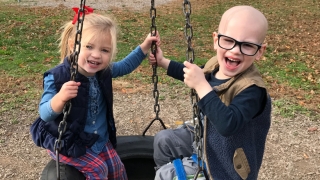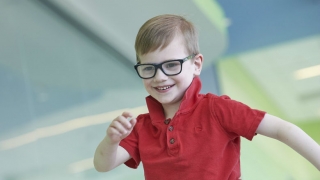Ewing Sarcoma: Blaise’s Story
Published on
Published on
Blaise is an energetic 4-year-old who likes to roughhouse with his little sister, Lucy, play ball with older boys in the neighborhood, jump on the bed, and ignore his parents’ pleas to slow down.
 His mom and dad, Ann and Andrew, are delighted with all of it (though they wish he would do a better job of listening to them). Over the past year, Blaise has had chemotherapy and surgery for cancer, and to them it’s a wonderful sight to watch him regain his energy and mobility.
His mom and dad, Ann and Andrew, are delighted with all of it (though they wish he would do a better job of listening to them). Over the past year, Blaise has had chemotherapy and surgery for cancer, and to them it’s a wonderful sight to watch him regain his energy and mobility.
Ann and Andrew first noticed that something might be wrong with Blaise when he was limping during a pumpkin-picking outing in October 2015. They found a blister on his foot, so assumed that was the problem. The limp came and went over the next several weeks.
Things got worse over a weekend in mid-January, when the pain in Blaise’s leg got so bad that he couldn’t sleep. A trip to the emergency room didn’t bring any quick answers. Blaise was given Motrin® and sent home. But the pain didn’t go away and Blaise was miserable. Ann, who is a nurse at Children’s Hospital of Philadelphia (CHOP) and worked in oncology at the time, scheduled an appointment with an orthopedic specialist for a more thorough examination.
At CHOP, Blaise was seen by John Flynn, MD, chief of the Division of Orthopedics, who ordered an MRI and blood work. The MRI was done on Friday afternoon, and Ann remembers vividly the call she got at the end of that day. Wudbhav Sankar, MD, an orthopedic surgeon, told her the imaging showed something in the marrow of Blaise’s femur (thigh bone). Dr. Sankar thought it might be an infection, and he wanted to drain it in a procedure the next day.
What was expected be a 15-minute draining procedure took two hours when the surgical team discovered the problem wasn’t the infection they expected, but rather a growth of some kind. They took tissue samples (a biopsy) to make a diagnosis.
Three days later, Dr. Sankar came to Blaise’s room at CHOP with Alexandre Arkader, MD, a pediatric orthopedic surgeon and orthopedic oncologist, to explain the results of the biopsy to Ann and Andrew. The growth on Blaise’s femur was cancer, a malignant tumor. Dr. Arkader suspected it was Ewing sarcoma, a rare type of bone tumor that affects children, adolescents and young adults.
Full results of the biopsy confirmed Dr. Arkader’s suspicion. He sat down with Ann, Andrew and pediatric oncologist Rochelle Bagatelle, MD, to review the options. Ewing sarcoma is an aggressive cancer, so as a first step they would need further testing to determine the stage of the cancer. They would get Blaise started on the appropriate chemotherapy right away, then he would need surgery to remove the growth, which meant removing a section of his femur.
“The good thing about being at CHOP,” says Ann, “was that no matter what it turned out to be, we had access to the best doctors and specialists. When we first found out there was something wrong with Blaise’s femur, I took comfort in that, at least.”
Dr. Arkader suggested a treatment plan that would safely remove the entire tumor while also, allowing him to keep growing normally and fully return to all physical activities. “Blaise was very young — he had just turned 4 — and not only he has a lot of remaining growth, but the level of activity of a child his age needed to play important role in the surgical plan,” says Dr. Arkader. “We decided that the best strategy was to utilize bone graft, rather than metal, to replace the area of the bone resected with the tumor.”
Dr. Arkader recommended a procedure he has performed several times for young patients like Blaise: intercalary wide resection of the tumor followed by vascularized free fibular grafting. “The fibula is one of two bones in the lower section of the leg,” he says. “Partial excision of the fibula does not compromise the stability or function of the leg. By using Blaise’s own fibula to repair the femoral defect, he would end up with a full living, growing femur — and the prospect of a normal, active future.”
“For the microvascular repair of the graft, we worked with Dr. Scott Levin, Chair of the Department of Orthopaedic Surgery at the Hospital of the University of Pennsylvania, who has a huge amount of experience in these kinds of procedures.”
Ann and Andrew agreed to Dr. Arkader’s plan. Blaise began chemotherapy that week, and the surgery was scheduled for May. Blaise would need 14 cycles of chemotherapy, with the surgery performed in the middle.
The day finally came. “They warned us that it would be a long surgery,” says Andrew, “and it was. Blaise was gone for 12 hours.” When the surgeons were done, the tumor was gone, and Blaise had a successfully grafted femur.
“He was in a full leg cast for 8 weeks, ending July 4,” says Ann. “When they took the cast off, his leg looked beautiful. He had a fine scar on the outside of his leg, from ankle to knee and knee to hip. When I mentioned how thin the scar was to Dr. Arkader, he admitted that he had been able to close the wound without staples.”
 Since then, Blaise has been steadily regaining his strength and resuming a normal life. He was allowed to start putting weight on the leg at the end of August, and he began to walk with a brace and a walker. “The team at CHOP pushed us to put him back in school,” Ann says. “It was good for him to get back with other kids. Lucy is at the same school. She’s a year-and-a-half younger than Blaise, but she looks out for him. And he has friends there.”
Since then, Blaise has been steadily regaining his strength and resuming a normal life. He was allowed to start putting weight on the leg at the end of August, and he began to walk with a brace and a walker. “The team at CHOP pushed us to put him back in school,” Ann says. “It was good for him to get back with other kids. Lucy is at the same school. She’s a year-and-a-half younger than Blaise, but she looks out for him. And he has friends there.”
Asked how he gets around and plays with other kids, Andrew answers: “Like any other 4-year-old. He’s fast with the walker. He runs around. He loves to roughhouse. He’ll go up to older kids in the neighborhood and ask to join their basketball game, and they are great with him.”
“He’s a sweet kid,” says Ann. “Every day he’s more and more full of life.”
“Everyone at CHOP has been so supportive,” she says. “They anticipated our needs and helped us whenever we had questions. They showed us how to take him to the beach without getting sand in his cast. They helped us get a handicap parking tag so we could park closer to where we were going while he had the full leg cast. They just love him, and it shows.”